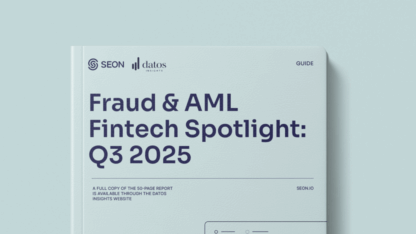Despite its origins in 1970, the Bank Secrecy Act (BSA) remains a cornerstone of financial crime prevention, yet its complexities still challenge many organizations. In 2024, regulators ramped up enforcement, issuing over three dozen actions against banks and individuals for failures in BSA, Anti-Money Laundering (AML), and Countering the Financing of Terrorism (CFT) compliance — some resulting in record-breaking penalties. As financial crime evolves, so do regulatory expectations, making it essential for institutions to adapt their compliance strategies.
This article unpacks the latest developments in BSA/AML compliance and offers actionable insights to help businesses effectively navigate this dynamic regulatory landscape.
What Is BSA AML Compliance?
The Bank Secrecy Act (BSA), also known as the Currency and Foreign Transaction Reporting Act, is a foundational US anti-money laundering (AML) law enacted in 1970. It mandates that financial institutions collaborate with the government to combat money laundering and other financial crimes.
To remain compliant, financial institutions must adhere to several key requirements:
- Reporting large cash transactions: Filing a Currency Transaction Report (CTR) for cash transactions exceeding $10,000.
- Customer identification: Identifying individuals involved in these transactions.
- Record keeping: Maintaining accurate records of transactions and customer identities.
The Financial Crimes Enforcement Network (FinCEN) enforces compliance with BSA/AML regulations. The BSA is an evolving piece of legislation, with amendments and guidance extending its reach beyond traditional financial institutions.
Today, it applies to a diverse range of sectors, including hemp-related businesses, cryptocurrencies, and online casinos. Additionally, the BSA intersects with other significant AML regulations, such as the USA Patriot Act and the National Defense Authorization Act.
Discover how a crypto platform used SEON to block fraudsters, strengthen compliance and streamline operations with fewer manual reviews.
Read the case study
What Are the Pillars of BSA AML Compliance?
BSA AML compliance is built on five essential pillars, each designed to ensure effective monitoring and prevention of money laundering and financial crime.
These pillars are the following:
- Internal controls: Financial institutions must implement robust internal controls and BSA AML monitoring systems to detect and report suspicious activities in a timely manner. These controls should be tailored to the institution’s risk profile and updated regularly to address emerging threats.
- Designation of a BSA AML officer: A dedicated compliance officer must be appointed to oversee the institution’s BSA AML program. This officer should have direct access to senior management or the board of directors, ensuring accountability and alignment with organizational priorities.
- BSA AML training program: Comprehensive training programs are crucial for equipping staff with the knowledge needed to identify and address money laundering risks. Training must be tailored to specific roles, documented and updated frequently to reflect changes in regulations or internal processes.
- Independent testing: Regular independent testing of the compliance program is required to evaluate its effectiveness. This includes assessing policies, procedures, transaction monitoring systems and training programs, ensuring alignment with regulatory standards.
- Customer Due Diligence (CDD): Introduced as the fifth pillar in 2018 under FinCEN’s CDD Rule, CDD involves verifying customer identities, understanding the nature of customer relationships, assigning risk profiles and conducting ongoing monitoring to identify high-risk customers and suspicious transactions. Effective CDD is integral to maintaining accurate customer information and mitigating risks.
Together, these pillars form the foundation of a strong BSA AML compliance program. Institutions that neglect any pillar risk significant regulatory penalties and reputational damage, underscoring the importance of comprehensive BSA AML monitoring and adherence to these requirements.
Who Must Comply With the Bank Secrecy Act & AML?
The Bank Secrecy Act is first and foremost aimed at US financial institutions. However, the term encompasses more types of businesses than banks and brokers. Under the BSA, financial institutions can be:
- insured banks
- credit unions
- brokers or dealers in securities or commodities
- currency exchanges
- pawnbrokers
- loan and finance companies
- travel agencies
- real estate companies
- vehicle retailers, including those selling airplanes, boats and automobiles
- dealers in precious metals, stones or jewels.
- hemp banking
Moreover, companies within certain industries fall within the definition of financial institutions if they meet specific requirements.
To be subject, casinos and gambling establishments, for instance, must have an annual gaming revenue of more than $1,000,000 and be licensed.
Who Enforces BSA Anti-Money Laundering Compliance?
BSA compliance is enforced by the Financial Crimes Enforcement Network (FinCEN). Its mission is to “safeguard the financial system from the abuses of financial crime, including terrorist financing, money laundering, and other illicit activity”.
Note that the Financial Industry Regulatory Authority (FINRA), which writes and enforces rules governing registered brokers and broker-dealer firms in the United States, can also check some AML regulations.
List of BSA/AML Report Types
Reporting plays a big part in BSA compliance. There are five key types of reports to fill:
CTR – Currency transaction reports:
A currency transaction report, or CTR, keeps a log of transactions exceeding $10,000 in a single business day. This includes multiple transactions amounting to that sum from the same customer. The report must include a bank account number, name, address, and social security number.
SAR – Suspicious activity report:
A SAR must be filled whenever your organization suspects a customer action points to money laundering, wire transfer fraud, or check fraud. Some AML software tools let you create these automatically.
FBAR – Foreign bank account report
An FBAR is designed to list US residents and citizens with a financial interest tied to foreign bank accounts.
MIL –Monetary instrument log
A MIL must keep track of cash purchases of monetary instruments such as checks above a value of $3,000. Financial institutions must keep that record for at least five years. Note that purchases above $10,000 must be logged on CTRs instead.
How to Establish an Effective BSA Compliance Program
To establish a strong BSA compliance program, start by aligning with the five key pillars required by the Financial Crimes Enforcement Network (FinCEN). Given the close relationship between BSA and Anti-Money Laundering (AML) regulations, it’s also essential to follow an AML compliance checklist to ensure full regulatory adherence.
Key steps to strengthen your BSA compliance process:
- Fulfill AML requirements: Implement a written, risk-based AML program that includes customer due diligence (CDD), ongoing monitoring and suspicious activity reporting (SARs).
- Utilize digital footprint analysis for pre-KYC and AML screening: Leverage real-time data to detect risk signals before onboarding customers.
- Implement risk-based monitoring: Adjust your fraud and AML controls based on customer risk profiles, transaction patterns and evolving threats.
- Deploy advanced transaction monitoring: Use AI-driven transaction monitoring tools to identify suspicious activity, reduce false positives and streamline compliance efforts.
With transaction monitoring more critical than ever, we break down the top six solutions to help you detect fraud, prevent money laundering and stay compliant.
Learn more
How SEON Can Augment Your AML and BSA Checks
SEON helps businesses meet AML and BSA requirements with real-time monitoring, dynamic risk scoring and AI-driven fraud detection. Key capabilities include:
- AML monitoring & screening: Detect high-risk individuals by screening transactions and user data against global watchlists, PEPs, sanctions lists and adverse media.
- AI-powered transaction monitoring: Leverage machine learning to analyze transactions in real time, spotting anomalies and potential fraud.
- Customizable risk scoring: Define risk thresholds and automate decisions to reduce manual reviews and false positives.
- Digital footprint analysis and device intelligence: Assess users instantly using real-time email, phone and IP data, as well as hardware and software specifications and behavioral biometrics, minimizing reliance on costly KYC checks.
- Seamless integration: Get started quickly with flexible API integration, low-code options and AWS Marketplace availability.
SEON’s modular and scalable solution ensures compliance while optimizing fraud prevention efforts.
FAQs
A number of companies offer BSA and AML certification programs, which aim to train, test, and prepare individuals for BSA compliance. The price and duration of each program will vary depending on the provider and scope.
BSA AML compliance software is designed to monitor transactions, create real-time alerts, and automatically fill the appropriate reports pertaining to BSA law.
Companies who fail to comply with BSA AML mandates risk severe fines as well as potential imprisonment for staff deemed responsible for this. In the USA, where the BSA applies, civil penalties imposed by banking regulators can be as high as $1 million for every single day the violation occurs. Similar AML legislation in the UK can result in up to 14 years of imprisonment, and you can expect similar consequences in most countries.
You might also be interested in:
- SEON: AML Compliance Program: What is It & How to Set it Up
- SEON: AML in Banking: Its Importance & How to Remain Compliant
- SEON: How to Reduce the Cost of AML
Sources
- FinCEN.gov: The Bank Secrecy Act
- FinCEN.gov: Information on Complying with the Customer Due Diligence (CDD) Final Rule









